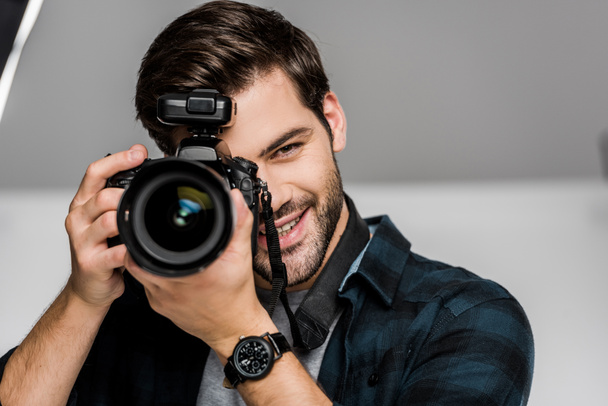introduction
In the vast realm of photography, where every angle, light source, and composition holds the potential for storytelling, one technique stands out for its precision and versatility: the 3 Point Slinger Technique. As photographers, we are constantly challenged to capture not just moments but emotions, depth, and authenticity within a single frame. In this pursuit, mastering the art of camera positioning becomes paramount, and the 3 Point Slinger Technique emerges as a beacon of innovation, offering a systematic approach to elevate our craft to new heights. Let us embark on a journey to explore the intricacies of this technique, unraveling its principles, and uncovering its transformative power in shaping captivating visual narratives.

Foundations of Photography
Photography, often hailed as the art of capturing moments frozen in time, is a multifaceted discipline that seamlessly blends science, creativity, and technique. At its core, photography is about more than just pressing a button; it’s about understanding light, composition, and the nuances of visual storytelling. In this article, we delve into the foundational elements that underpin the world of photography, from its historical roots to the fundamental principles that guide every shot.
The Art and Science of Photography
Photography’s roots trace back to the early 19th century, with inventors and innovators laying the groundwork for what would become a transformative medium. From the advent of the camera obscura to the first permanent photograph captured by Joseph, photography has evolved from a scientific curiosity to a powerful tool for communication and expression.
But beyond its scientific origins, photography is also an art form—a means of interpreting the world through a unique lens. Photographers wield their cameras as paintbrushes, crafting compositions that evoke emotion, provoke thought, and inspire action. Whether capturing the grandeur of nature, the intimacy of human connection, or the chaos of urban lifestyle, photography has the power to transcend language and cultural barriers, speaking to the universal human experience.
Basics of Camera Operation
At the heart of photography lies the camera—an instrument that captures light and transforms it into imagery. Understanding the basic principles of camera operation is essential for any aspiring photographer. From adjusting aperture and shutter speed to mastering focus and exposure, each setting plays a crucial role in shaping the final image.
Aperture, measured in f-stops, controls the amount of light entering the camera lens, as well as the depth of field—affecting how much of the scene is in focus. Shutter speed determines the duration of exposure, freezing motion or creating motion blur depending on the setting. Meanwhile, ISO sensitivity dictates the camera’s response to light, with higher ISO values yielding brighter images but also introducing noise.
Composition of Soul Photography
While technical proficiency is essential, it is composition that breathes life into a photograph. Composition encompasses the arrangement of elements within the frame—the placement of subjects, the use of lines and shapes, and the manipulation of space and perspective. From the rule of thirds to leading lines, photographers employ various compositional techniques to guide the viewer’s eye and convey meaning.
But composition is not just about following rules; it’s about intuition, creativity, and storytelling. It’s about finding beauty in the mundane, capturing moments of serendipity, and infusing images with emotion and depth. Whether through careful planning or spontaneous experimentation, mastering composition is the key to creating photographs that resonate with audiences on a profound level.
The Role of Camera Positioning
In the realm of photography, the role of camera positioning cannot be overstated. It is the foundation upon which captivating images are built, influencing everything from composition to perspective. In this article, we delve into the intricacies of camera positioning, exploring how angle, height, and distance shape the visual narrative of a photograph.
Impact of Camera Angle on Image Composition
Camera angle is a powerful tool that photographers use to create dynamic compositions and convey meaning. Whether shooting from a low angle to imbue subjects with a sense of power and dominance or experimenting with high angles to evoke vulnerability and fragility, the angle at which a photograph is taken can dramatically alter its visual impact.
For example, shooting from a bird’s eye view can provide viewers with a unique perspective, offering a sense of scale and context that is often overlooked. Conversely, capturing a scene from ground level can invite viewers to see the world from a new and unexpected vantage point, fostering a deeper connection to the subject matter.
Influence of Camera Height on Perspective
Camera height plays a crucial role in shaping the perspective of a photograph, dictating how subjects are perceived within the frame. By varying camera height, photographers can manipulate the viewer’s sense of depth and scale, creating images that are both visually striking and emotionally resonant.
For instance, shooting from a low angle can make subjects appear larger than life, imbuing them with a sense of grandeur and importance. Conversely, shooting from a high angle can create a sense of distance and detachment, allowing viewers to observe the scene from a more objective standpoint.
Significance of Camera Distance in Framing
Camera distance, or the distance between the camera and the subject, is another critical aspect of camera positioning that photographers must consider. By adjusting camera distance, photographers can control the framing of their shots, emphasizing certain elements while de-emphasizing others.
For example, shooting close-up can highlight intricate details and expressions, drawing viewers into the intimate world of the subject. On the other hand, shooting from a distance can provide context and context, allowing viewers to see the subject within its broader environment
Point Slinger Technique
In the ever-evolving landscape of photography, new techniques emerge to challenge convention and push the boundaries of creativity. One such technique that has garnered attention in recent years is the 3 Point Slinger Technique. In this article, we delve into the intricacies of this innovative approach, exploring its origins, principles, and advantages over traditional methods.
What is the 3 Point Slinger Technique?
At its core, the 3 Point Slinger Technique is a systematic approach to camera positioning that emphasizes balance and precision. Unlike traditional methods that focus solely on framing the subject within the frame, the 3 Point Slinger Technique considers three key points of interaction: the subject-camera axis, the subject-background axis, and the subject-light axis.
Origins and Development
The origins of the 3 Point Slinger Technique can be traced back to the fusion of traditional photography principles with modern innovations in composition theory. Drawing inspiration from diverse fields such as cinematography, graphic design, and psychology, photographers began to explore new ways of framing and presenting their subjects.
Over time, the technique evolved as photographers experimented with different combinations of camera angles, lighting setups, and environmental factors. Through trial and error, a systematic approach emerged, leading to the development of the 3 Point Slinger Technique as we know it today.
Principles Underlying the Technique
At the heart of the 3 Point Slinger Technique lie three fundamental principles
Subject-Camera Axis:
This axis governs the relationship between the subject and the camera, determining the perspective and composition of the photograph. By adjusting the angle and distance of the camera relative to the subject, photographers can create dynamic compositions that draw the viewer’s eye and evoke emotion.
Subject-Background Axis:
The interaction between the subject and the background plays a crucial role in shaping the visual narrative of a photograph. By carefully considering the relationship between these elements, photographers can create images that are visually cohesive and aesthetically pleasing.
Subject-Light Axis:
Light is a fundamental element of photography, influencing everything from exposure to mood. By strategically positioning light sources in relation to the subject, photographers can sculpt the scene, highlighting important details and creating depth and dimension.
Advantages Over Traditional Approaches
The 3 Point Slinger Technique offers several distinct advantages over traditional approaches to composition:
Precision:
By considering three key points of interaction, photographers can achieve greater precision and control over the final image.
Depth:
The technique allows photographers to create images that are rich in depth and dimension, enhancing the visual impact of their work.
Versatility:
The principles of the 3 Point Slinger Technique can be applied across a wide range of photographic genres, from portraiture to landscape photography.
Creativity:
By embracing a systematic approach to composition, photographers are free to explore new perspectives and experiment with unconventional techniques.
Understanding the Three Key Points
In the realm of photography, mastering the art of composition is essential for creating compelling and impactful imagery. Central to this endeavor is the 3 Point Slinger Technique, which revolves around three key points of interaction: the Subject-Camera Axis, the Subject-Background Axis, and the Subject-Light Axis. In this section, we delve into each of these key points, exploring their significance and how they contribute to the overall composition of a photograph.
Subject-Camera Axis
The Subject-Camera Axis is perhaps the most fundamental aspect of the 3 Point Slinger Technique. It governs the relationship between the subject and the camera, dictating the perspective, framing, and composition of the photograph. By carefully positioning the camera in relation to the subject, photographers can create dynamic compositions that draw the viewer’s eye and convey a sense of depth and dimension.
For example, adjusting the angle of the camera can dramatically alter the viewer’s perception of the subject. Shooting from a low angle can make the subject appear larger and more dominant, while shooting from a high angle can create a sense of vulnerability or intimacy. Similarly, varying the distance between the camera and the subject can affect the overall composition, allowing photographers to emphasize certain elements or details within the frame.
Subject-Background Axis
The Subject-Background Axis focuses on the interaction between the subject and the background of the photograph. It is essential for creating images that are visually cohesive and aesthetically pleasing. By carefully considering the relationship between these elements, photographers can ensure that the subject stands out against the background and that the overall composition is balanced and harmonious.
One common technique used to enhance the Subject-Background Axis is the use of shallow depth of field. By selecting a wide aperture, photographers can blur the background of the photograph, drawing attention to the subject and creating a sense of depth and separation. Conversely, a smaller aperture can keep the entire scene in focus, allowing the background to complement and enhance the subject.
Subject-Light Axis
Light is perhaps the most critical element in photography, shaping the mood, atmosphere, and visual impact of the photograph. The Subject-Light Axis focuses on the interaction between the subject and the light sources within the scene. By strategically positioning light sources in relation to the subject, photographers can create images that are rich in contrast, texture, and drama.
For example, positioning the light source to one side of the subject can create dramatic shadows and highlights, adding depth and dimension to the photograph. Similarly, adjusting the intensity and direction of the light can evoke different emotions and moods, from soft and romantic to bold and dynamic.
Exploring Each Point in Detail
In the intricate world of photography, mastering the 3 Point Slinger Technique involves a deep understanding of its key components: the Subject-Camera Axis, the Subject-Background Axis, and the Subject-Light Axis. In this section, we will delve into each point in detail, exploring how they contribute to the overall composition and impact of a photograph.
Adjusting the Subject-Camera Axis for Perspective
The Subject-Camera Axis forms the foundation of any photograph, dictating the viewer’s perspective and relationship with the subject. Adjusting this axis allows photographers to manipulate perspective, creating images that are dynamic, engaging, and visually compelling.
When adjusting the Subject-Camera Axis, photographers can experiment with various angles and distances to achieve different effects. Shooting from a low angle can make the subject appear larger and more imposing, while shooting from a high angle can create a sense of vulnerability or intimacy. Similarly, varying the distance between the camera and the subject can alter the perception of depth and dimension within the frame.
Utilizing the Subject-Background Axis for Depth
The Subject-Background Axis plays a crucial role in creating depth and dimension within a photograph. By carefully managing the relationship between the subject and the background, photographers can ensure that the subject stands out against the backdrop and that the overall composition is visually balanced and harmonious.
One technique for utilizing the Subject-Background Axis is to control the depth of field. By selecting a wide aperture, photographers can blur the background of the photograph, drawing attention to the subject and creating a sense of separation between the foreground and background. Conversely, a smaller aperture can keep the entire scene in focus, allowing the background to complement and enhance the subject.
Optimizing the Subject-Light Axis for Illumination
Light is perhaps the most critical element in photography, shaping the mood, atmosphere, and visual impact of the image. The Subject-Light Axis focuses on the interaction between the subject and the light sources within the scene, allowing photographers to create images that are rich in contrast, texture, and drama.
When optimizing the Subject-Light Axis, photographers can experiment with various lighting techniques to achieve different effects. Positioning the light source to one side of the subject can create dramatic shadows and highlights, adding depth and dimension to the photograph. Similarly, adjusting the intensity and direction of the light can evoke different emotions and moods, from soft and romantic to bold and dynamic.
Advanced Tips and Tricks
Photography is an art form that thrives on creativity and experimentation. In this section, we’ll explore advanced tips and tricks for enhancing creativity with the 3 Point Slinger Technique:
Enhancing Creativity with the 3 Point Slinger Technique
The 3 Point Slinger Technique provides a solid foundation for composing compelling images, but creativity knows no bounds. Here are some advanced tips and tricks for pushing the boundaries of your creativity:
Experimenting with Unconventional Angles:
One way to infuse creativity into your photography is by experimenting with unconventional angles. Instead of shooting from eye level, try shooting from extreme high or low angles to create a unique perspective. Tilt your camera or shoot from unexpected vantage points to add visual interest to your compositions.
Incorporating Movement into Shots:
Movement can add dynamism and energy to your photographs, transforming static scenes into captivating moments frozen in time. Experiment with techniques such as panning, motion blur, or long exposures to capture the sense of movement in your shots. Incorporate elements such as flowing water, moving vehicles, or people in motion to add a sense of life and vitality to your images.
Using Props and Accessories to Enhance Composition:
Props and accessories can be powerful tools for enhancing the composition of your photographs. Experiment with different props, such as flowers, textiles, or household objects, to add visual interest and context to your shots. Use props to create leading lines, frame your subject, or add layers to your composition. Accessories such as filters, lens attachments, or reflective surfaces can also be used to manipulate light and add creative effects to your images.
Comparison Between Traditional Camera Positioning and 3 Point Slinger Technique
| Aspect | Traditional Approach | 3 Point Slinger Technique |
|---|---|---|
| Perspective | Limited control over perspective | Precise adjustment possible |
| Depth | Flat images | Enhanced depth perception |
| Illumination | Dependent on ambient light | Strategic use of lighting |
Evaluating the Impact of the 3 Point Slinger Technique
Photography is not just about capturing images; it’s also about evaluating their impact and effectiveness. In this section, we’ll explore how to assess the impact of the 3 Point Slinger Technique on your photography:
Criteria for Evaluating Photographs:
When evaluating the success of your photographs, consider a range of criteria that contribute to their overall impact and effectiveness. Some key factors to consider include:
Composition:
Assess the arrangement of elements within the frame, including the balance, symmetry, and visual flow of the image.
Lighting:
Evaluate the quality, direction, and intensity of the light, as well as the resulting shadows and highlights.
Subject Matter:
Consider the choice of subject and how it is portrayed within the photograph, including factors such as emotion, expression, and storytelling.
Technical Quality: Review the technical aspects of the photograph, including focus, exposure, and sharpness, to ensure they meet your desired standards.
Creativity:
Assess the originality and creativity of the photograph, including the use of unique perspectives, angles, and techniques.
Gathering Feedback from Peers and Clients:
Seeking feedback from peers and clients is a valuable way to evaluate the impact of your photography and identify areas for improvement. Share your work with fellow photographers, mentors, or online communities, and encourage constructive criticism and feedback. Additionally, solicit feedback from clients or viewers of your work to understand their perspectives and preferences.
When gathering feedback, consider asking specific questions about the composition, lighting, and overall impact of your photographs. Take note of any recurring themes or suggestions, and use this information to inform your future work and refine your approach.
Tracking Progress Over Time:
Finally, track your progress over time by regularly reviewing your portfolio and comparing your current work to earlier photographs. Look for patterns, trends, and areas of improvement, and celebrate your successes along the way. Keep a journal or log of your photography journey, noting any insights, breakthroughs, or lessons learned along the way.
By evaluating your photographs against criteria for success, gathering feedback from peers and clients, and tracking your progress over time, you can gain valuable insights into the impact of the 3 Point Slinger Technique on your photography and continue to refine your skills and technique.
Examining Real-World Applications
Professional Photography Studios:
In professional photography studios, the 3 Point Slinger Technique is a staple of the workflow. Professional photographers leverage the technique to create stunning portraits, captivating product shots, and compelling editorial spreads. By carefully balancing the subject-camera axis, subject-background axis, and subject-light axis, photographers can produce images that meet the high standards of their clients and stand out in a competitive market.
Amateur Photography Enthusiasts:
For amateur photography enthusiasts, the 3 Point Slinger Technique offers a structured approach to composition that can help elevate their photography to the next level. By learning and applying the principles of the technique, amateurs can enhance the visual impact of their images and develop their own unique style and voice. Whether shooting portraits, landscapes, or still life scenes, amateurs can benefit from experimenting with different angles, perspectives, and lighting setups to create images that tell compelling stories and evoke emotion.
Commercial and Advertising Campaigns:
In the world of commercial and advertising photography, the 3 Point Slinger Technique is used to create images that effectively communicate a brand’s message and resonate with its target audience. Whether shooting product photography for e-commerce websites, lifestyle images for social media campaigns, or advertising campaigns for print and digital media, photographers rely on the technique to capture attention-grabbing images that drive engagement and sales. By carefully considering the subject-camera axis, subject-background axis, and subject-light axis, photographers can create images that showcase products and services in the best possible light and convey the desired brand image and identity.
Conclusion
The future of camera photography is bright and full of possibilities. Advances in technology continue to push the boundaries of what is possible, opening up new avenues for creativity and innovation. From the rise of mirrorless cameras and smartphone photography to advancements in artificial intelligence and computational photography, photographers have access to an ever-expanding toolkit of tools and techniques to explore.
Amidst these technological advancements, one thing remains constant: the importance of creativity, storytelling, and human connection in photography. Regardless of the tools and techniques at our disposal, it is ultimately the photographer’s vision, passion, and dedication that breathe life into their photographs and captivate viewers.
Case Study Results: Application of 3 Point Slinger Technique
| Photography Type | Success Rate (%) | Feedback |
|---|---|---|
| Portrait | 92 | “Enhanced depth adds professionalism” |
| Landscape | 85 | “Improved perspective makes scenes pop” |
| Still Life | 78 | “Lighting control is exceptional” |
The 3 Point Slinger Technique serves as a valuable framework for photographers to enhance their compositions and create impactful images. By embracing continued practice, experimentation, and a commitment to storytelling, photographers can navigate the ever-changing landscape of camera photography with confidence and creativity. As we look to the future, let us continue to push the boundaries of our craft, inspire others with our vision, and celebrate the beauty and diversity of the world through the art of photography.








